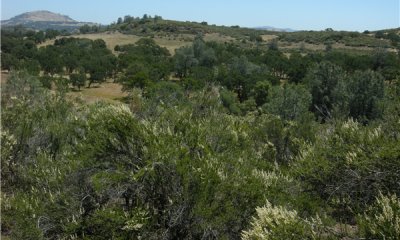
Thermic Ultramafic Foothills Moderately High Magnesium Content (Ca:Mg Ratio 0.5 To 2)
Circle-spoke model
Scenario model
Current ecosystem state
Select a state
Management practices/drivers
Select a transition or restoration pathway
-
No transition or restoration pathway between the selected states has been described
Target ecosystem state
Select a state
State 1
Reference State




Description
State 1 represents the historic range of variability for this ecological site. Ultramafic soils often offer a refuge to many native endemic herbaceous species (e.g. red hills soap root plant (Chlorogalum grandiflorum; Calflora.org, 2016) because its unique soil chemistry is not amenable to the vast majority of plant species. Some of the endemic plants are still intact, despite the introduction of a number of annual grasses and forbs arriving after the discovery of the New World. However, most of the plants found in this ecological site can also be encountered in non-ultramafic soils. They are indifferent to the harsh soil conditions found in ultramafic areas and not great serpentinite indicators (See Bodenvag plants, Kruckeberg, 1984).
The different community phases below differ slightly in hydrological function and nutrient dynamics. For example, the post-fire phase (community phase 1.2) is more vulnerable to erosion, especially when significant precipitation events occur in the months following the fire. Within 2-3 years, there is generally enough plant cover to retain the soil. Community phases 1.1 and 1.3 are generally more stable and are less prone to erosion. However, it must be recognized that many of these ultramafic bands occur on undulating and less steep soils (< 35%), and thus do not pose as great a threat as chaparral communities in other ecological sites with more relief.
Submodel
Model keys
Briefcase
Add ecological sites and Major Land Resource Areas to your briefcase by clicking on the briefcase (![]() ) icon wherever it occurs. Drag and drop items to reorder. Cookies are used to store briefcase items between browsing sessions. Because of this, the number of items that can be added to your briefcase is limited, and briefcase items added on one device and browser cannot be accessed from another device or browser. Users who do not wish to place cookies on their devices should not use the briefcase tool. Briefcase cookies serve no other purpose than described here and are deleted whenever browsing history is cleared.
) icon wherever it occurs. Drag and drop items to reorder. Cookies are used to store briefcase items between browsing sessions. Because of this, the number of items that can be added to your briefcase is limited, and briefcase items added on one device and browser cannot be accessed from another device or browser. Users who do not wish to place cookies on their devices should not use the briefcase tool. Briefcase cookies serve no other purpose than described here and are deleted whenever browsing history is cleared.
Ecological sites
Major Land Resource Areas
The Ecosystem Dynamics Interpretive Tool is an information system framework developed by the USDA-ARS Jornada Experimental Range, USDA Natural Resources Conservation Service, and New Mexico State University.
